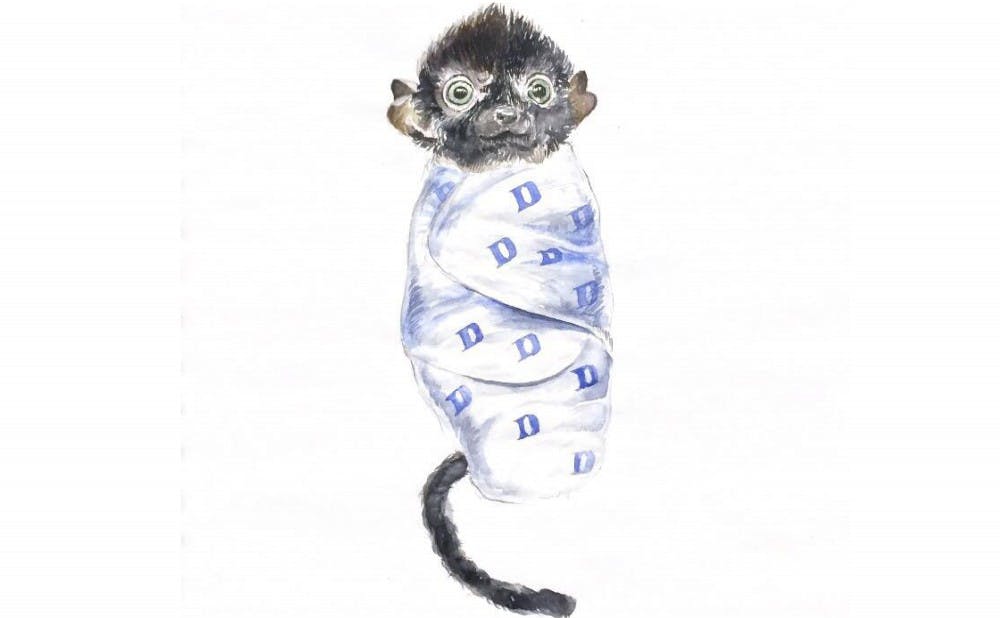Classes are over and campus is quiet, but the Duke Lemur Center is still hopping thanks to the arrival of three new—and rare—furry friends.
The Lemur Center has welcomed three blue-eyed black lemur infants into its family this birthing season—two in March and one in April. Born March 14, Gellar was named after the actress Sarah Michelle Gellar, who played the protagonist Buffy in the popular show Buffy the Vampire Slayer. Just more than a week later, Hamill—whose namesake is Star Wars actor Mark Hamill—was born March 22.
“There are different naming themes for each species of lemur that we have here at the [Lemur Center]," said Sara Clark, director of communications at the Lemur Center. "All of our blue-eyed black lemurs are named after blue-eyed celebrities."
Mark Hamill told the Lemur Center that he was “very honored” to have a lemur named after him, Clark shared, adding that they have yet to receive a response from Sarah Michelle Gellar.
Gellar and Hamill—who respectively weighed 71 grams and 72 grams at birth—are healthy infants. Over the past few months, they have continued to grow and are “definitely becoming bolder,” Clark said.
When lemurs are young, they cling to their mother’s belly or back, rarely leaving her side. As they get older, they begin to explore their surroundings, moving farther away from her.
“Hamill, for example, started out being less than a foot away from [his mother] at all times, but now he’s venturing [out] a little bit further,” Clark said. “He’s crawling on his brother Lincoln, which is really cute to watch.”
Although visitors to the Lemur Center this summer will not be able to see Gellar and Hamill, two other blue-eyed black lemurs named Presley and Kidman will be visible from the tour path.
Blue-eyed black lemurs are an endangered species—it is estimated that there are less than 1,000 of these lemurs left in the wild on Madagascar. There are five females of breeding age in North America, and the Lemur Center is home to four of them—including Hamill’s mother West and Gellar’s mother Wiig, Clark explained.
“This is a really interesting and charismatic species, [but] they are very critically endangered lemurs—the most rare species that we have here at the Lemur Center,” Clark said. “A few years ago, it was estimated that they would be extinct in the wild in less than a decade.”
Clark shared that Gellar and Hamill are part of a conservation breeding program that is working to create a “genetic safety net” for the species in the event that blue-eyed black lemurs go extinct in the wild.
Clark added that there may be more lemur birth announcements in the near future.
“We do hope to announce some more infants very soon, but you’ll have to stay tuned,” she told The Chronicle at the beginning of May.
Almost three weeks later, the Lemur Center announced the birth of Ranomasina—another blue-eyed black lemur. This newborn's name means "sea" in Malagasy, which is the national language of Madagascar.
Ranomasina was delivered by cesarean section April 12, weighing under three ounces, according to a press release. Lemur births via c-section are extremely rare—the surgery has only been performed 15 times in the Lemur Center's 50-year history.
While Hamill and Gellar's parents were born in North America, Ranomasina's parents were moved to the center from Madagascar in 2017, making this newborn even more unique.
Before Ranomasina was born, every blue-eyed black lemur born in North America was descended from seven wild lemurs imported by the Lemur Center from Madagascar in 1985 and 1990. Now, Ranomasina's genes will help diversify the captive lemur population's genetic pool.
“With the birth of Ranomasina, for the first time since 1990, we have a whole new lineage of blue-eyed black lemurs coming into the North American population,” said Cathy Williams, curator of animals at the Duke Lemur Center, in the press release. "The more genetically diverse a population is, the more resilient it is, the healthier it is, and the better it can adapt to environmental pressures.”
Get The Chronicle straight to your inbox
Signup for our weekly newsletter. Cancel at any time.

